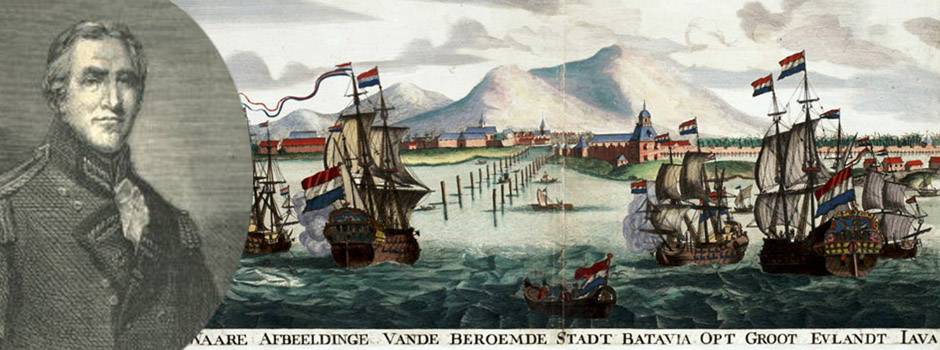The Soldiers’ Return

This text is abridged (slightly) from notes by Rev Col AJ Mackenzie on what he calls “The Saga of Uig”, an account particularly of the Old Soldiers of the Seaforth Highlanders who served all over the globe during the Napoleonic wars. The picture shows the city of Batavia in Java in 1665, well before the 78th got there (artist unknown; National Archives of the Netherlands) and Col Alexander Mackenzie Fraser, commander of the 1st Battalion until his death in 1809.
After the devastating loss of their ensign and countryman, Lieutenant John Munro, at Weltevreeden in Java on 10 June 1811, the soldiers of the 78th Seaforth Regiment endured several years away before returning home. After a long struggle lasting several weeks, the British defeated the Dutch and took possession of Java, and the men of the 78th were among those chosen to form the permanent garrison. They remained there for four years, during which time they were sent on an expedition against the Sultan of Jogjakarta, whom they took prisoner and whose rich treasure they acquired. It wasn’t all glory, however, and of the 1027 of the Regiment in 1811, only 400 remained, the others having died in battle or from the heat and fevers. After the victory of Waterloo on 1815, a long series of wars came to a close, and the 78th began to make their way home.
On the 5th of November 1816, the 78th embarked for Calcutta. Their trials were not yet at an end, for on the way they were wrecked on the Isles of Prepares in the Bay of Bengal and 14 soldiers were lost. They were soon rescued from this perilous position and on 12thDececmeber they assembled at Fort William. There they received orders to prepare to embark for Europe. The 1st and 2nd Battalions, so much depleted, merged finally and were sent to Ireland where they were stationed at Mullingar for nine years.
But sometime after 13 July 1817, the Old Soldiers of Uig began to return to their native hills. During their long absence little or nothing was known about them. Letter writing was a rare art in those days. I imagine few, if any, of the old soldiers had acquired any proficiency in writing. Even if they had, the transmission of letters was a slow process and their deliver uncertain. Occasionally, I suppose, a list of those who had fallen in battle, or who had died of disease, would come to the minister, but of the living little was know.
After the death of Lieutenant Munro in 1811 they probably lost all touch with home. They themselves were so young when they went away, and so ignorant of the geography of their own island, that when they arrived back inStornoway they did not know the way across the moor, and had to wait there until someone chanced to come from Uig and act as guide to them.
It is easy to understand the interest their return caused in the parish. Their company was much sought after, both for their own sterling worth and for the sake of the wonderful tales they had to tell of hard fought battles and far distant lands. Wherever they went they were assured of a hearty welcome. Goldsmith gives a true picture of the old soldier of those days:
The vet’ran soldier, kindly bade to stay,
Set by his fire and talked the night away,
Wept over his wounds and tales of sorrow done;
Shoulder’d his crutch, and show’d how fields were won.
There was nothing of the rude character traditionally attributed to the old soldier about these men. As Munro Mackenzie (the factor, and nephew of Ensign Munro, in his report to the Napier Commission in 1883) remarked, they were all good men – worthy descendants of the long generations of heroes whose exploits had already created in the parish a saga to which their own natural aptitude for recounting their adventures now added a new chapter.
The majority of those who returned at this time were undoubtedly Saighdearan Mac a’ Mhinisteir (recruited 1804) but it is just possible that there were also some of the Saighdearan Cnoc a’ Champ (1793) amongst them. Some, I imagine, through wounds or sickness, had possibly obtained their discharge and had returned home before this. The blinded soldiers of Rosetta must certainly have returned soon after 1807.
More about the Old Soldiers (including Rev Col Mackenzie’s list of men.)
